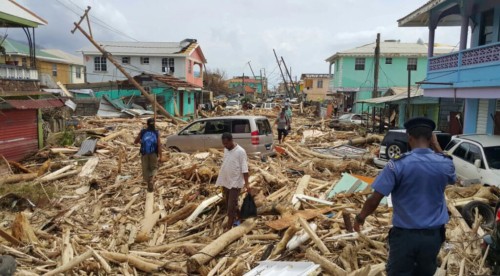Caribbean Among Countries With No Multi-Hazard Early Warning Systems
BRIDGETOWN, Barbados – A new global report released on Wednesday has found that some Caribbean countries do not have multi-hazard early warning systems even as climate change and increasingly extreme weather events, have caused a surge in natural disasters over the past 50 years disproportionately impacting poorer countries.
 Dominica Destroyed by Hurricane Maria in 2017. Photo by: AFP – Getty ImagesThe World Meteorological Organization (WMO) and UN Office for Disaster Risk Reduction (UNDRR) in its report titled “Atlas of Mortality and Economic Losses from Weather, Climate and Water Extremes, from 1970 to 2019,” noted that these natural hazards accounted for 50 per cent of all disasters, 45 per cent of all reported deaths and 74 per cent of all reported economic losses.
Dominica Destroyed by Hurricane Maria in 2017. Photo by: AFP – Getty ImagesThe World Meteorological Organization (WMO) and UN Office for Disaster Risk Reduction (UNDRR) in its report titled “Atlas of Mortality and Economic Losses from Weather, Climate and Water Extremes, from 1970 to 2019,” noted that these natural hazards accounted for 50 per cent of all disasters, 45 per cent of all reported deaths and 74 per cent of all reported economic losses.
There were more than 11,000 reported disasters attributed to these hazards globally, with just over two million deaths and US$3.64 trillion in losses. More than 91 per cent of the deaths occurred in developing countries, the report noted.
It said that only half of WMO’s 193 member countries have multi-hazard early warning systems and severe gaps in weather and hydrological observing networks exist in Africa, some parts of Latin America and in Pacific and Caribbean island States.
“More lives are being saved thanks to early warning systems, but it is also true that the number of people exposed to disaster risk is increasing due to population growth in hazard-exposed areas and the growing intensity and frequency of weather events.
“More international cooperation is needed to tackle the chronic problem of huge numbers of people being displaced each year by floods, storms and drought”, said Mami Mizutori, the UN Special Representative and head of the Office for Disaster Risk Reduction.
She called for a greater investment in comprehensive disaster risk management to ensure that climate change adaptation is integrated in national and local disaster risk reduction strategies.
The UNDRR chief warned that the failure to reduce disasters losses as set out in the 2015 Sendal Framework is putting at risk the ability of developing countries to eradicate poverty and to achieve other important Sustainable Development Goals (SDGs).
The Sendai Framework for Disaster Risk Reduction 2015-2030 (Sendai Framework) was the first major agreement of the post-2015 development agenda and provides member states with concrete actions to protect development gains from the risk of disaster.
The report further recommends countries to review hazard exposure and vulnerability considering a changing climate to reflect that tropical cyclones may have different tracks, intensity and speed than in the past.
It also calls for the development of integrated and proactive policies on slow-onset disasters such as drought.
According to the report from 1970 to 2019, North America, Central America and the Caribbean suffered 74,839 deaths and US$1.7 trillion economic losses.
It said the region accounted for 18 per cent of weather, climate and water-related disasters, four per cent of associated deaths and 45 per cent of associated economic losses worldwide.
According to the report, storms were responsible for 54 per cent and floods, 31 per cent of recorded disasters, with the former linked to 71 per cent of deaths and the latter to 78 per cent of economic losses.
On the issue of climate change and increasingly extreme weather events, the report notes they have caused a surge in natural disasters over the past 50 years disproportionately impacting poorer countries.
The economic losses have increased sevenfold from the 1970s to the 2010s, going from an average of US$49 million, to a whopping US$383 million per day globally.
Storms, the most prevalent cause of damage, resulted in the largest economic losses around the globe.
“Three of the costliest 10 disasters, all hurricanes that occurred in 2017, accounted for 35 per cent of total economic disaster losses around the world from 1970 to 2019. In the United States, Hurricane Harvey caused US$96.9 billion in damage, Maria in the Caribbean US$69.4 billion, and Irma US$58.2 billion in Cape Verde,” the report noted.


